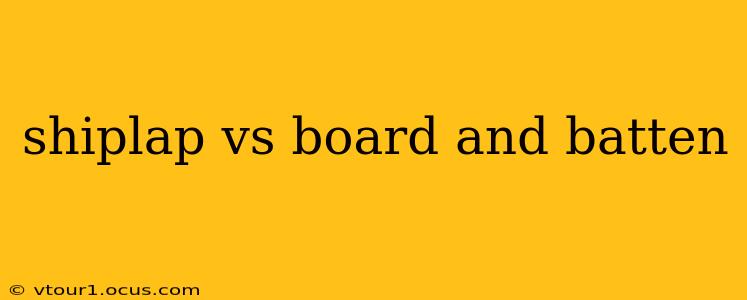Choosing the right exterior siding can significantly impact your home's curb appeal and value. Two popular options, shiplap and board and batten, offer distinct aesthetics and functionalities. This comprehensive guide will delve into the key differences between shiplap and board and batten, helping you make an informed decision for your home.
What is Shiplap?
Shiplap siding is characterized by its overlapping horizontal planks. The distinctive groove on one edge of each plank allows for a snug, weather-resistant fit when installed. This overlapping design creates a clean, seamless look, popularized in recent years for its rustic charm and modern farmhouse appeal. Traditionally used for barns and utilitarian structures, shiplap's versatility now makes it a favorite for both interior and exterior applications.
What is Board and Batten?
Board and batten siding features wider vertical boards, separated and framed by narrower strips of wood called battens. This creates a more textured and defined look compared to shiplap's smoother surface. The battens not only add visual interest but also serve a practical purpose, covering the gaps between the boards and further enhancing weather protection. Board and batten offers a classic, traditional aesthetic often associated with colonial or craftsman-style homes.
Shiplap vs. Board and Batten: Key Differences
While both shiplap and board and batten use wood planks, several key distinctions set them apart:
-
Orientation: Shiplap runs horizontally, while board and batten runs vertically. This fundamental difference dramatically alters the visual impact on your home's exterior. Horizontal shiplap can make a home appear wider, while vertical board and batten can create an impression of height.
-
Visual Appeal: Shiplap offers a clean, minimalist aesthetic, perfect for modern or farmhouse styles. Board and batten, with its vertical lines and battens, creates a more textured, traditional, and sometimes more formal appearance.
-
Installation: Both can be relatively straightforward to install, but the vertical nature of board and batten might require slightly more precise measuring and cutting. The overlapping nature of shiplap simplifies installation, but careful attention must still be paid to ensure a tight, weatherproof seal.
-
Maintenance: Both shiplap and board and batten require regular maintenance, including cleaning and repainting or restaining as needed. The choice of wood (e.g., cedar, redwood) and the quality of the finish will affect long-term maintenance requirements.
-
Cost: Pricing can vary greatly depending on the type of wood, the quality of the materials, and labor costs. Generally, the cost per square foot may be comparable for both, though the overall cost can depend on the size of the project and the intricacy of installation.
Which is Right for My Home?
The best choice depends entirely on your personal preferences, architectural style, and budget. Consider these factors:
-
Home Style: Shiplap complements modern, farmhouse, and coastal styles. Board and batten is well-suited to traditional, colonial, craftsman, and even some contemporary homes.
-
Desired Aesthetic: Do you prefer a clean, minimalist look (shiplap) or a more textured, detailed appearance (board and batten)?
-
Budget: Obtain quotes from multiple contractors to compare installation costs for both options.
-
Climate: Both can withstand various climates, but the choice of wood and quality of installation impact weather resistance.
What are the different materials used for shiplap and board and batten?
Both shiplap and board and batten siding can be constructed from various materials, including wood (cedar, redwood, pine), fiber cement, vinyl, and even engineered wood. Wood offers a natural aesthetic and can be stained or painted, while fiber cement provides durability and low maintenance. Vinyl is an economical choice, but it may not offer the same aesthetic appeal as natural wood. The material choice will significantly influence cost and maintenance requirements.
How much does shiplap and board and batten siding cost?
The cost of shiplap and board and batten varies significantly based on the material (wood type, fiber cement, vinyl), labor costs, and the size of the project. Expect to pay a higher price for natural wood options compared to vinyl alternatives. It's always best to obtain multiple quotes from reputable contractors to get an accurate estimate for your specific project.
Is shiplap or board and batten more durable?
The durability of both shiplap and board and batten depends largely on the materials used and the quality of the installation. Fiber cement options tend to be more durable and weather-resistant than wood, offering longer lifespans with less maintenance. However, properly installed and maintained wood siding can also last for many years.
By carefully weighing these factors, you can confidently select the siding that best enhances your home's beauty and longevity. Remember to consult with professionals for accurate cost estimates and expert installation advice.
